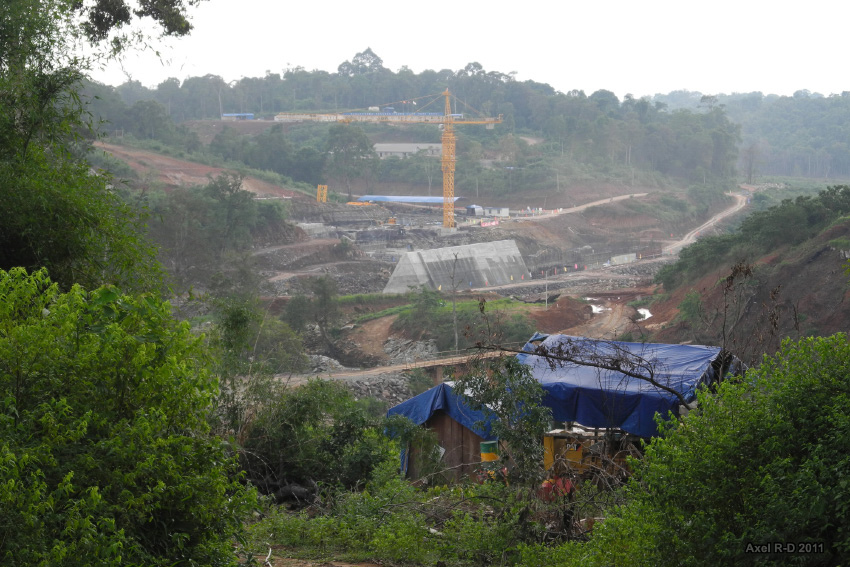នៅក្នុងឆ្នាំ ២០០៣ ការវាយតម្លៃវិស័យវារីអគ្គិសនីថ្នាក់ជាតិ ត្រូវបានធ្វើឡើងដោយក្រសួងឧស្សាហកម្ម រ៉ែ និងថាមពល (បច្ចុប្បន្នជា ក្រសួងរ៉ែ និងថាមពល) និងគណៈកម្មាធិការជាតិទន្លេមេគង្គកម្ពុជា (CNMC)។ របាយការណ៍នេះ បានកំណត់ទីតាំងដែលមានសក្តានុពលចំនួន ៦០កន្លែង សម្រាប់ការអភិវឌ្ឍថាមពលវារីអគ្គិសនីក្នុងប្រទេសកម្ពុជា និងបានប៉ាន់ស្មានពីសក្តានុពលផលិតថាមពលសរុបទូទាំងប្រទេសប្រមាណ ១០,០០០ មេហ្គាវ៉ាត់ ដែលក្នុងនោះ ៥០ ភាគរយ គឺស្ថិតនៅតាមដងទន្លេមេគង្គ និង ៤០ ភាគរយ នៅតាមដៃទន្លេមេគង្គ និង ១០ ភាគរយ នៅភាគនិរតីខាងក្រៅអាងទន្លេមេគង្គ។1 នៅដើមឆ្នាំ ២០១៩ ប្រទេសកម្ពុជាមិនបានសាងសង់ទំនប់ណាមួយ នៅតាមបណ្តោយទន្លេមេគង្គទេ។

ទំនប់វារីអគ្គិសនីកំពុងសាងសង់។ រូបភាព ថតដោយ Axel Drainville, ២៦ មេសា ២០១១។ ក្រោមអាជ្ញាប័ណ្ណ CC BY-NC 2.0។
ស្ថានភាពបច្ចុប្បន្ននៃការអភិវឌ្ឍទំនប់វារីអគ្គីសនី
ថាមពលអគ្គិសនីដែលផលិតចេញពីទំនប់វារីអគ្គិសនី កើនឡើងយ៉ាងខ្លាំងនៅក្នុងរយៈពេលប៉ុន្មានឆ្នាំថ្មីៗនេះ។ ជាឧទាហរណ៍ ក្នុងឆ្នាំ២០១១ ថាមពលអគ្គិសនីដែលផលិតចេញពីប្រភពថាមពលនេះមានត្រឹមតែ ៥១,៥ ជីហ្គាវ៉ាត់ម៉ោង2 ហើយនៅត្រឹមឆ្នាំ២០១៦ ការផលិតបានកើនឡើងជិត ៥០ដង ដែលស្មើនឹង ២៥៦៧,៩ ជីហ្គាវ៉ាត់ម៉ោង ដោយសារតែទំនប់វារីអគ្គិសនីជាច្រើនបានចាប់ផ្ដើមដំណើរការ។3
ទំនប់វារីអគ្គិសនីដែលកំពុងដំណើរការរួមមាន៖4
- ទំនប់វារីអគ្គិសនី គីរីរម្យ១ (១២ មេហ្គាវ៉ាត់) ស្ថិតក្នុងខេត្តកំពង់ស្ពឺ
- ទំនប់វារីអគ្គិសនី កំចាយ (១៩៣ មេហ្គាវ៉ាត់) ស្ថិតក្នុងខេត្តកំពត ដែលបានចាប់ដំណើរការនៅឆ្នាំ ២០១១
- ទំនប់វារីអគ្គិសនី គីរីរម្យ៣ (១៨ មេហ្គាវ៉ាត់) បានចាប់ដំណើរការនៅឆ្នាំ ២០១៣
- ទំនប់វារីអគ្គិសនី ស្ទឹងអាតៃ (១២០ មេហ្គាវ៉ាត់) ស្ថិតក្នុងខេត្តពោធិ៍សាត់ ដែលបានចាប់ដំណើរការនៅឆ្នាំ ២០១៣
- ទំនប់វារីអគ្គិសនី ស្ទឹងឫស្សីជ្រុំក្រោម (៣៣៨ មេហ្គាវ៉ាត់) ស្ថិតក្នុងខេត្តកោះកុង ដែលបានចាប់ដំណើរការនៅឆ្នាំ ២០១៤
- ទំនប់វារីអគ្គិសនី ស្ទឹងតាតៃ (២៤៦ មេហ្គាវ៉ាត់) ស្ថិតក្នុងខេត្តកោះកុង ដែលបានដំណើរការក្នុងឆ្នាំ ២០១៤។
- ទំនប់វារីអគ្គិសនីសេសានក្រោម២ (៤០០ មេហ្គាវ៉ាត់) ស្ថិតក្នុងខេត្តស្ទឹងត្រែង បានចាប់ផ្ដើមដំណើរការជាផ្លូវការក្នុងឆ្នាំ ២០១៨។
ទំនប់វារីអគ្គិសនីទាំងនេះត្រូវបានភ្ជាប់ទៅបណ្តាញអគ្គិសនីជាតិ។ ក៏មានរោងចក្រវារីអគ្គិសនីនៅខេត្តរតនគិរី និងមួយទៀតនៅខេត្តមណ្ឌលគិរីត្រូវបានភ្ជាប់ទៅនឹងបណ្តាញអគ្គិសនី នៅរតនគិរី និងមណ្ឌលគិរីរបស់អគ្គិសនីកម្ពុជា។5
ទំនប់វារីអគ្គិសនីសេសានក្រោម២ ត្រូវបានសាងសង់ក្រោមវិនិយោគរួមគ្នារវាងក្រុមហ៊ុនចិន Hydrolancang International Energy (៥១ ភាគរយ) ក្រុមហ៊ុនកម្ពុជា រ៉ូយ៉ាល់គ្រុប (៣៩ ភាគរយ) និងក្រុមហ៊ុនវៀតណាម Vietnam Electricity (EVN) (១០ ភាគរយ)។6 ទំនប់វារីអគ្គិសនីនេះត្រូវបានសាងសង់ក្រោមកិច្ចសន្យាសាងសង់-អាជីវកម្ម-និងផ្ទេរ (ស.អ.ផ) មានរយៈពេលសម្បទាន ៤៥ ឆ្នាំ។ នៅដើមឆ្នាំ ២០១៦ ក្រសួងរ៉ែ និងថាមពលបានបង្កើតគណៈកម្មាធិការជាតិមួយ ដែលដឹកនាំដោយ រដ្ឋមន្ត្រីក្រសួងរ៉ែ និងថាមពល លោក ស៊ុយ សែម ដើម្បីដោះស្រាយបញ្ហាសំណង និងការតាំងទីលំនៅថ្មីសម្រាប់ប្រជាពលរដ្ឋចំនួន ១០០០គ្រួសារ ដែលផ្លាស់ទីលំនៅ ដោយសារទំនប់នេះ។ គ្រួសារដែលរងផលប៉ះពាល់ជាច្រើនបានច្រានចោលកញ្ចប់សំណងរបស់រាជរដ្ឋាភិបាល ដែលមានលំនៅដ្ឋានទំហំ ៨០ ម៉ែត្រការ៉េ និងដីដាំដុះចំនួន ៥ ហិកតា ដោយមិនគិតពីតម្លៃអចលនទ្រព្យចាស់របស់ពួកគេ។7

ទំនប់វារីអគ្គីសនី សេសានក្រោម២។ រូបភាព ថតដោយ Prachatai, ២៤ មិថុនា ២០១៥។ ក្រោមអាជ្ញាប័ណ្ណ CC BY-NC-ND 2.0។
គម្រោងជាច្រើនផ្សេងទៀតក្នុងតំបន់ភាគឦសាន ដែលកំពុងស្ថិតក្រោមការសិក្សាបុរេលទ្ធភាពមានដូចជា ទន្លេសេសានក្រោម ៣, ទន្លេសេសានក្រោម ១/៥, ទន្លេស្រែពក ៣ និង ៤ និងព្រែកលាំង ១ និង ២។
ចំណែកតំបន់ភាគអាគ្នេយ៍ ទំនប់ស្ទឹងជាយអារ៉ែងក៏ត្រូវបានសិក្សាដែរ។8 យ៉ាងណាក៏ដោយ សំណើសម្រាប់ទំនប់វារីអគ្គិសនីនៅជ្រលងអារ៉ែង ត្រូវបានជំទាស់យ៉ាងខ្លាំងដោយអ្នកបរិស្ថាន និងក្រុមជនជាតិដើមភាគតិចនៅក្នុងតំបន់នេះ។ សំណើនេះត្រូវបានលុបចោល ដោយលោកនាយករដ្ឋមន្ត្រី ហ៊ុន សែន បាននិយាយថារោងចក្រធ្យូងថ្មថ្មីមួយនឹងត្រូវបានសាងសង់ នៅក្នុងខេត្តព្រះសីហនុជំនួសវិញ។9
ក្រៅពីនេះ ទំនប់ធំៗពីរ កំពុងស្ថិតក្រោមការពិចារណាតាមដងទន្លេមេគង្គ មានដូចជា សំបូរ (៤៦៥ មេហ្គាវ៉ាត់) និងស្ទឹងត្រែង (៩៨០ មេហ្គាវ៉ាត់)។ យ៉ាងនេះក្តី មានភាពចម្រូងចម្រាស់ជាច្រើនពាក់ព័ន្ធនឹងការអភិវឌ្ឍទំនប់វារីអគ្គិសនីតាមដងទន្លេនេះ។
ក្របខណ្ឌច្បាប់ និងបទបញ្ញត្តិសម្រាប់ទំនប់វារីអគ្គិសនី
ក្រសួងសំខាន់ដែលទទួលខុសត្រូវលើការអភិវឌ្ឍវិស័យទំនប់វារីអគ្គិសនីកម្ពុជា គឺក្រសួងរ៉ែ និងថាមពល (អតីតជាក្រសួងឧស្សាហកម្ម រ៉ែ និងថាមពល)។10 ចំណែកឯ អគ្គិសនីកម្ពុជា (EdC) ដែលជាក្រុមហ៊ុនផ្គត់ផ្គង់ថាមពលអគ្គិសនីរបស់រដ្ឋ ទទួលខុសត្រូវលើការគ្រប់គ្រងវិស័យអគ្គិសនីប្រចាំថ្ងៃ និងអាជ្ញាធរអគ្គិសនីកម្ពុជា (EAC) ទទួលខុសត្រូវលើការផ្តល់អាជ្ញាប័ណ្ណផលិត និងបញ្ជូនថាមពលអគ្គិសនី។11
បច្ចុប្បន្ននេះ មិនមានច្បាប់ស្តីពីវារីអគ្គិសនីនៅក្នុងប្រទេសកម្ពុជាឡើយ ទោះបីជាមានច្បាប់មួយចំនួនពាក់ព័ន្ធនឹងការអភិវឌ្ឍ និងប្រតិបត្តិការគម្រោងទាំងនោះក៏ដោយ រួមទាំងច្បាប់ដែលទាក់ទងនឹងការវិនិយោគ អគ្គិសនី ដីធ្លី ព្រៃឈើ ធនធានទឹក និងបរិស្ថានជាដើម។
ជំហានដំបូងនៅក្នុងការអភិវឌ្ឍគម្រោងទំនប់វារីអគ្គិសនី គឺត្រូវធ្វើអនុស្សរណៈយោគយល់គ្នាជាមួយនឹងក្រសួងរ៉ែ និងថាមពល ដើម្បីរៀបចំ និងធ្វើការសិក្សាបុរេលទ្ធភាពគម្រោង ដែលតាមធម្មតាអាចចំណាយពេលពី មួយឆ្នាំ ទៅពីរឆ្នាំ ដើម្បីបញ្ចប់។ បន្ទាប់ពីបញ្ចប់ការសិក្សាបុរេលទ្ធភាព ក្រុមហ៊ុនអាចធ្វើការពិភាក្សាជាបន្តទៀតជាមួយនឹងក្រសួងរ៉ែ និងថាមពលអំពីការអភិវឌ្ឍគម្រោង។12
គ្រប់គម្រោងទាំងអស់ ដែលមានទឹកប្រាក់វិនិយោគលើសពី ៥០លានដុល្លារអាមេរិក និងរាល់គម្រោង BOT ទាំងអស់ ត្រូវតែអនុម័តដោយ ក្រុមប្រឹក្សាអភិវឌ្ឍន៍កម្ពុជា (CDC)13 ដែលជាស្ថាប័នធ្វើសេចក្តីសម្រេចខ្ពស់បំផុត សម្រាប់ការវិនិយោគក្នុងវិស័យឯកជន និងសាធារណៈ នៅក្នុងប្រទេសកម្ពុជា។14 ក្រៅពីនេះ នៅក្រោមច្បាប់ស្តីពីការគ្រប់គ្រងធនធានទឹក រាល់គម្រោងវារីអគ្គិសនីទាំងអស់ តម្រូវឲ្យមានអាជ្ញាប័ណ្ណប្រើប្រាស់ទឹក ដែលចេញដោយក្រសួងធនធានទឹក និងឧតុនិយម។15
រាល់គម្រោងវារីអគ្គិសនីទាំងអស់ ត្រូវតែមានការវាយតម្លៃហេតុប៉ះពាល់បរិស្ថាន មុនពេលដែលគម្រោងទាំងនោះត្រូវបានអនុម័ត16 ហើយការវាយតម្លៃហេតុប៉ះពាល់បរិស្ថាន គប្បីត្រូវបានធ្វើឡើង ដោយអនុលោមទៅតាមនីតិវិធី ដែលបានកំណត់ដោយក្រសួងបរិស្ថាន។17 លទ្ធផល ដែលទទួលបានពីការវាយតម្លៃហេតុប៉ះពាល់បរិស្ថាននោះ គប្បីត្រូវបានយកមកពិចារណាក្នុងការធ្វើសេចក្តីសម្រេចចិត្តចុងក្រោយ ថាតើត្រូវផ្តល់ការអនុម័តដល់គម្រោង ឬយ៉ាងណា។
និន្នាការដែលកំពុងលេចរូបរាងឡើង
ដោយហេតុថាវិស័យវារីអគ្គិសនីក្នុងប្រទេសកម្ពុជា ស្ថិតនៅក្នុងដំណាក់កាលដំបូងនៃការអភិវឌ្ឍនៅឡើយនោះ គេមិនប្រាកដថា តើនិន្នាការអ្វីនឹងកើតមានឡើងទេ។ ដូចគ្នានេះដែរ យើងនៅតែមិនទាន់ដឹងច្បាស់ថា អត្ថប្រយោជន៍នឹងត្រូវសម្រេចបានឬអត់ នឹងត្រូវសម្រេចបានដោយរបៀបណា ហើយតើផលប៉ះពាល់របស់វា នឹងត្រូវបានកាត់បន្ថយគ្រប់គ្រាន់ដែរឬអត់។
ជាការពិតណាស់ គម្រោងវារីអគ្គិសនីខ្នាតធំៗភាគច្រើន អាចធ្វើអោយមានការជន់លិចធំ។ ឧទាហរណ៍៖ គម្រោងទំនប់វារីអគ្គិសនីសេសានក្រោម២ នឹងធ្វើអោយមានការជន់លិច ផ្ទៃដីជាង ៣៤០ គីឡូម៉ែត្រការ៉េ។ ទីតាំងគម្រោងដែលត្រូវបានស្នើសុំ ភាគច្រើនស្ថិតនៅក្នុងតំបន់ព្រៃដែលមានជីវៈចម្រុះសំបូរបែប និងប្រព័ន្ធបរិស្ថានងាយប្រែប្រួល ដែលនឹងទទួលរងនូវផលប៉ះពាល់យ៉ាងធ្ងន់ធ្ងរ ពីការអភិវឌ្ឍលក្ខណៈបែបនេះ។ ផលប៉ះពាល់ទៅលើការបន្លាស់ទីរបស់ត្រី និងលទ្ធភាពប្រើប្រាស់ផលិតផលព្រៃឈើ គម្រាមកំហែងដល់ជីវភាពរបស់ប្រជាជនមូលដ្ឋាន ក៏ដូចជាការជន់លិចលើផ្ទៃដីកសិកម្ម និងដីសម្រាប់លំនៅដ្ឋាន។
ការសិក្សាក្រុមប្រឹក្សាមួយដោយគណៈកម្មការទន្លេមេគង្គ បានរកឃើញផលប៉ះពាល់ដ៏ធំមួយដែលអាចកើតមានទៅលើសន្តិសុខស្បៀង នៅកម្ពុជាដែលបណ្ដាលមកពីការអភិវឌ្ឍទំនប់។18 សេណារីយោជាមួយនឹងការអភិវឌ្ឍទំនប់វារីអគ្គិសនីពេញលេញបានព្យាករណ៍ការធ្លាក់ចុះនៃផលិតកម្មជលផលរហូតដល់ទៅ ៧០ ភាគរយ នៅក្នុងអាងទន្លេមេគង្គ។ សម្រាប់កម្ពុជា ការខាតបង់ GDP ប្រចាំឆ្នាំ ត្រូវបានព្យាករណ៍ថា មានទំហំចាប់ពី ៣ ទៅ ៥ ពាន់លានដុល្លារអាមេរិក ក្រោមសេណារីយោរហូតដល់ឆ្នាំ២០៤០។19 បើតាមលោក ណៅ ធួក រដ្ឋលេខាធិការក្រសួងកសិកម្ម រុក្ខប្រមាញ់ និងនេសាទបានឲ្យដឹងថាការព្យាករដោយផ្ទាល់របស់រាជរដ្ឋាភិបាលគឺធ្លាក់ចុះពី ១៦ ទៅ ៣០ ភាគរយចំពោះជីវម៉ាស់ត្រី។
គម្រោងវារីអគ្គិសនីខ្នាតធំ នឹងបង្កអោយមាននូវផលប៉ះពាល់ ដោយចៀសមិនផុតទៅលើបរិស្ថាន។ អាស្រ័យហេតុនេះ គម្រោងបែបនេះ ត្រូវតែមានការវាយតម្លៃហេតុប៉ះពាល់បរិស្ថាន អោយបានត្រឹមត្រូវ ហើយប្រសិនបើត្រូវបានអនុម័តនោះ គម្រោងបែបនេះ ត្រូវតែមានវិធានការទប់ស្កាត់សមស្របជាស្រេច ដើម្បីកាត់បន្ថយនូវរាល់ផលប៉ះពាល់អវិជ្ជមាននានា។
ការរំពឹងទុកសម្រាប់ពេលអនាគត
វិស័យថាមពលរបស់ប្រទេសកម្ពុជា ត្រូវការការអភិវឌ្ឍយ៉ាងច្រើន ទាំងការផលិត និងការបញ្ជូនថាមពល ដើម្បីបំពេញតម្រូវការកាន់តែច្រើនឡើងៗ របស់ប្រជាពលរដ្ឋរបស់ខ្លួន និងដើម្បីផ្តល់នូវការផ្គត់ផ្គង់ថាមពលដែលមានស្ថេរភាព និងមានតម្លៃសមរម្យ ដើម្បីទាក់ទាញអ្នកវិនិយោគទុនដែលមានសក្តានុពល។ រាជរដ្ឋាភិបាលកម្ពុជា បានមើលឃើញវារីអគ្គិសនី ថាជាផ្នែកអាទិភាព សម្រាប់ការអភិវឌ្ឍនៅក្នុងវិស័យថាមពល។ នៅក្នុងរយៈពេលប៉ុន្មានឆ្នាំកន្លងទៅនេះ វិនិយោគិន និងអ្នកអភិវឌ្ឍន៍មកពីប្រទេសចិន វៀតណាម កូរ៉េ រុស្ស៊ី កាណាដា និងជប៉ុន បានធ្វើការសិក្សាអំពីលទ្ធភាពអភិវឌ្ឍន៍វារីអគ្គិសនីក្នុងប្រទេសកម្ពុជា។
ស្របពេលដែលការអភិវឌ្ឍវិស័យវារីអគ្គិសនី កំពុងមានដំណើរការស្ទុះទៅមុខនោះ ក្តីបារម្ភនានា ក៏ត្រូវបានលើកឡើងដោយក្រុមសង្គមស៊ីវិល និងសហគមន៍ជាច្រើន ដែលទទួលរងនូវផលប៉ះពាល់ពីគម្រោងវារីអគ្គិសនី ថាផលប៉ះពាល់អវិជ្ជមានរបស់គម្រោង មិនទាន់មានការយកចិត្តទុកដាក់ឱ្យបានគ្រប់គ្រាន់នៅឡើយ ហើយការពិគ្រោះយោបល់សាធារណៈ ក៏មិនបានធ្វើឡើងអោយបានគ្រប់គ្រាន់។ ការវាយតម្លៃហេតុប៉ះពាល់បរិស្ថានដែលមានគុណភាពខ្ពស់ និងការធ្វើសេចក្តីសម្រេចដោយបើកចំហ គឺជាប្រការដ៏សំខាន់ ដើម្បីធានាថាវិស័យវារីអគ្គិសនីនៃប្រទេសកម្ពុជា ត្រូវបានអភិវឌ្ឍឡើងទៅតាមវិធីដែលកាត់បន្ថយផលប៉ះពាល់បានច្រើនបំផុត ខណៈដែលការទាញយកអត្ថប្រយោជន៍បានអតិបរមា សម្រាប់ប្រទេសកម្ពុជា និងវិនិយោគិនរបស់ខ្លួន។
បានធ្វើបច្ចុប្បន្នភាព៖ ២៧ កុម្ភៈ ២០១៩
ទាក់ទងនឹងទំនប់វារីអគ្គីសនី
- គោលនយោបាយ និងការគ្រប់គ្រងថាមពល
- ផលិតកម្មអគ្គីសនី
- ការវាយតម្លៃហេតុប៉ះពាល់បរិស្ថាន
- បរិស្ថាន និងធនធានធម្មជាតិ
ឯកសារយោង
- 1. គណៈកម្មាធិការជាតិទន្លេមេគង្គកម្ពុជា (រៀបចំដោយ ក្រសួងឧស្សាហកម្ម រ៉ែ និងថាមពល)។ ការវាយតម្លៃវិស័យអគ្គិសនីថ្នាក់ជាតិឆ្នាំ ២០០៣៖ ថាមពលវារីអគ្គិសនី ខែមិថុនា ឆ្នាំ២០០៣ (ទំព័រ ៥, ៨-៩)។
- 2. អាជ្ញាធរអគ្គិសនីកម្ពុជា ឆ្នាំ ២០១២។ របាយការណ៍វិស័យអគ្គិសនីនៃព្រះរាជាណាចក្រកម្ពុជា ចេញផ្សាយឆ្នាំ ២០១២។ https://www.eac.gov.kh/site/annualreport?lang=en ចូលអានថ្ងៃទី២៤ ខែមីនា ឆ្នាំ២០១៨។
- 3. អាជ្ញាធរអគ្គិសនីកម្ពុជា ឆ្នាំ ២០១៧។ របាយការណ៍វិស័យអគ្គិសនីនៃព្រះរាជាណាចក្រកម្ពុជា ចេញផ្សាយឆ្នាំ ២០១៧។ https://www.eac.gov.kh/site/annualreport?lang=en ចូលអានថ្ងៃទី២៤ ខែមីនា ឆ្នាំ២០១៨។
- 4. ដូចលេខយោងខាងលើ
- 5. អាជ្ញាធរអគ្គិសនីកម្ពុជា, របាយការណ៍វិស័យអគ្គិសនីនៃព្រះរាជាណាចក្រកម្ពុជា ទិន្នន័យសម្រាប់ឆ្នាំ ២០១៤។ https://eac.gov.kh/site/viewfile?param=annual_report%2Fkhmer%2FAnnual-Report-2014-kh.pdf ចូលអានថ្ងៃទី២៤ ខែមេសា ឆ្នាំ២០១៦។
- 6. សំណង់ និងអចលនទ្រព្យ ឆ្នាំ២០១៨។”ពិធីសម្ពោធទំនប់វារីអគ្គិសនីសេសានក្រោម២”, ថ្ងៃទី១៧ ខែធ្នូ ឆ្នាំ២០១៨។ https://www.construction-property.com/read-news-1549/ ចូលអានថ្ងៃទី២៨ ខែមករា ឆ្នាំ២០១៩។
- 7. ឡាយ សាមាន ឆ្នាំ២០១៦។ “ក្រសួងរ៉ែបង្កើតក្រុមដោះស្រាយផលប៉ះពាល់ពីការសង់ទំនប់”, កាសែតភ្នំពេញប៉ុស្ដិ៍, ថ្ងៃទី២៧ ខែមករា ឆ្នាំ២០១៦។ https://bit.ly/2URqlkB ចូលអានថ្ងៃទី៣០ ខែមករា ឆ្នាំ២០១៦។
- 8. អាជ្ញាធរអគ្គិសនីកម្ពុជា, របាយការណ៍វិស័យអគ្គិសនីនៃព្រះរាជាណាចក្រកម្ពុជា ទិន្នន័យសម្រាប់ឆ្នាំ ២០១៤។ https://opendevelopmentcambodia.net/dataset/?id=report-on-power-sector-of-the-kingdom-of-cambodia-2015-edition ចូលអានថ្ងៃទី២៤ ខែមេសា ឆ្នាំ២០១៦។
- 9. ម៉ៃ គុណមករា, ២០១៧។ “ក្រុមហ៊ុនToshba នឹងសាងសង់រោងចក្រធ្យូងថ្ម”, កាសែតខ្មែរថាមស៍, ថ្ងៃទី២៨ ខែកុម្ភៈ ឆ្នាំ២០១៧។
- 10. ច្បាប់ស្តីពីអគ្គិសនី, ឆ្នាំ២០០១។ មាត្រា៣។
- 11. ដូចលេខយោងខាងលើ
- 12. Middleton, C។ ការអភិវឌ្ឍនៃវារីអគ្គិសនីរបស់កម្ពុជា និងការពាក់ព័ន្ធរបស់ប្រទេសចិន។ អង្គការទន្លេអន្តរជាតិ និងអង្គការសម្ព័ន្ធទន្លេនៅកម្ពុជា។ ភ្នំពេញ, មករា ឆ្នាំ ២០០៨។
- 13. អនុក្រឹត្យស្តីពីការរៀបចំ និងប្រព្រឹត្តទៅនៃក្រុមប្រឹក្សាអភិវឌ្ឍន៍កម្ពុជា។ ឆ្នាំ ១៩៩៥។ មាត្រា៩។
- 14. ច្បាប់ស្តីពីការវិនិយោគក្នុងព្រះរាជាណាចក្រកម្ពុជា ឆ្នាំ ១៩៩៤, មាត្រា១។
- 15. ច្បាប់ស្តីពីការគ្រប់គ្រងធនធានទឹក ឆ្នាំ ២០០៧, មាត្រា១២។
- 16. ច្បាប់ស្តីពីកិច្ចការពារបរិស្ថាន និងការគ្រប់គ្រងធនធានធម្មជាតិ ឆ្នាំ ១៩៩៦, មាត្រា៦ និងអនុក្រឹត្យស្តីពីកិច្ចដំណើរការវាយតម្លៃហេតុប៉ះពាល់បរិស្ថាន ឆ្នាំ ១៩៩៩, ឧបសម្ព័ន្ធ។
- 17. ប្រកាសស្តីពីគោលការណ៍ណែនាំទូទៅក្នុងការធ្វើរបាយការណ៍វាយតម្លៃហេតុប៉ះពាល់បរិស្ថានដំបូង និងពេញលេញ ឆ្នាំ ២០០៩។
- 18. Alessandro Malazzi Sassoon ឆ្នាំ២០១៧, “MRC៖ ការសង់ទំនប់វារីអគ្គិសនីអាចធ្វើឱ្យប៉ះពាល់ធ្ងន់ធ្ងរដល់កម្ពុជា”, កាសែតភ្នំពេញប៉ុស្តិ៍, ថ្ងៃទី ២០ ខែធ្នូ ឆ្នាំ២០១៧។ http://www.phnompenhpost.com/national/cambodias-fisheries-risk-due-hydropower-development-mekong-mrc-warns ចូលអានថ្ងៃទី២៩ ខែធ្នូ ឆ្នាំ២០១៧។
- 19. ដូចលេខយោងខាងលើ។

